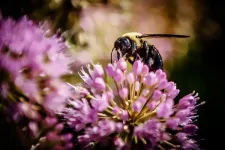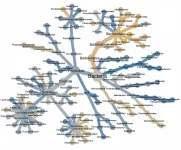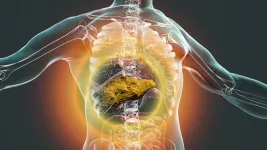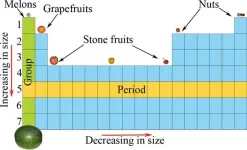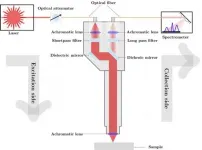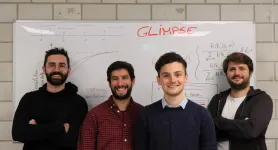INFORMATION:
Pollinators not getting the 'buzz' they need in news coverage
2021-01-13
(Press-News.org) CHAMPAIGN, Ill. -- A dramatic decline in bees and other pollinating insects presents a threat to the global food supply, yet it's getting little attention in mainstream news.
That's the conclusion of a study from researchers at the University of Illinois Urbana-Champaign, published this week in a special issue of the Proceedings of the National Academy of Sciences. The study was based on a search of nearly 25 million news items from six prominent U.S. and global news sources, among them The New York Times, The Washington Post and The Associated Press.
The study found "vanishingly low levels of attention to pollinator population topics" over several decades, even compared with what many would consider the limited coverage of climate change.
The study, titled "No buzz for bees," was led by Scott Althaus, the director of the U. of I. Cline Center for Advanced Social Research, and May Berenbaum, a leading expert on pollinator declines, head of Illinois' entomology department and one of three editors of the PNAS special issue.
The research utilized the Cline Center's Global News Index, a unique database of millions of news items from thousands of global news sources, published over decades.
"No study like this, and certainly not at this scale, has ever been done before," said Althaus, also an expert on news coverage and its effects. "There simply has not been academic research on the evolving nature of news coverage given to pollinator declines, despite the importance of that topic within the scientific community."
The study also analyzed decades of coverage in three English-language wire services based abroad: Agence France Presse, in France; Deutsche Presse Agentur, in Germany; and Xinhua General News Service, in China.
Berenbaum, often described as an "ambassador for insects," initiated the project out of a desire to gauge public awareness of the pollinator-decline issue. She said she was startled by the results.
"As much as the entomological community is gripped by this impending crisis, it appears the public isn't paying much attention," she said. "It's not that people are indifferent, it's just that they don't even know about it."
And they need to know about it, she said, because "it's a serious problem for everybody. Insects provide essential ecosystem services that people aren't aware of and take for granted, and for which we have no substitutes."
The Cline Center researchers, including study co-authors Jenna Jordan and Dan Shalmon, found that the minimal amount of news coverage on pollinator decline that appeared in the six news outlets was concentrated in The New York Times and The Washington Post, and then most often was relegated to science or other specialty sections. Rarely did pollinator news appear on the front page, Althaus said. "It's not making it into the mainstream of public affairs news coverage. As we look at wire service reporting in the U.S., we hardly see any coverage of this topic at all."
That was also true for the three English-language foreign-based wire services they looked at, Althaus said. "It's really difficult for us to know whether there might be specialty publications within these countries that are taking the issue up. But from what we can see for the broad-based wire service reporting, it is simply not on the radar screens of major news organizations in these other parts of the world."
Since the vast majority of studies on pollinator decline have been done in Europe and North America, Berenbaum said, "we don't even know how serious the problem is. Most insect biodiversity, including pollinator diversity, is in the tropics."
As for the factors contributing to pollinator decline, and insect decline generally, Berenbaum pointed to the introductory article for the special issue of PNAS, "Insect decline in the Anthropocene: Death by a thousand cuts," of which she is also a co-author. There's "no nice clean story with one bad guy and an easy solution," she said, but almost all the causes relate to human activities, from climate change to pollution to agriculture.
On an individual level, Berenbaum said, "we can make a difference in the decisions we make about what flowers we plant in our gardens, which weeds we tolerate in our yards, even how we manage insect pests. A single backyard bug zapper, for instance, can kill tens of thousands of harmless insects over the course of a summer, including many pollinators, while killing barely a thimble-full of mosquitoes."
ELSE PRESS RELEASES FROM THIS DATE:
Wetland methane cycling increased during ancient global warming event
2021-01-13
Wetlands are the dominant natural source of atmospheric methane, a potent greenhouse gas which is second only to carbon dioxide in its importance to climate change. Anthropogenic climate change is expected to enhance methane emissions from wetlands, resulting in further warming. However, wetland methane feedbacks were not fully assessed in the Intergovernmental Panel on Climate Change (IPCC) Fifth Assessment Report, posing a challenge to meeting the global greenhouse gas mitigation goals set under the Paris Agreement.
To understand how wetland methane cycling may evolve and drive climate feedbacks in the future, scientists are increasingly looking to Earth's past.
"Ice core records indicate ...
Spilling the beans on coffee's true identity
2021-01-13
People worldwide want their coffee to be both satisfying and reasonably priced. To meet these standards, roasters typically use a blend of two types of beans, arabica and robusta. But, some use more of the cheaper robusta than they acknowledge, as the bean composition is difficult to determine after roasting. Now, researchers reporting in ACS' Journal of Agricultural and Food Chemistry have developed a new way to assess exactly what's in that cup of joe.
Coffee blends can have good quality and flavor. However, arabica beans are more desirable than other types, resulting in a higher market value for blends containing a higher proportion of this variety. In some cases, producers dilute their blends with the less expensive robusta beans, yet that is hard for consumers ...
The cancer microbiome reveals which bacteria live in tumors
2021-01-13
DURHAM, N.C. -- Biomedical engineers at Duke University have devised an algorithm to remove contaminated microbial genetic information from The Cancer Genome Atlas (TCGA). With a clearer picture of the microbiota living in various organs in both healthy and cancerous states, researchers will now be able to find new biomarkers of disease and better understand how numerous cancers affect the human body.
In the first study using the newly decontaminated dataset, the researchers have already discovered that normal and cancerous organ tissues have a slightly different microbiota composition, that bacteria from these diseased sites can enter the bloodstream, and that this bacterial information could help diagnose ...
Scoring system to redefine how U.S. patients prioritized for liver transplant
2021-01-13
Liver transplant priority in the U.S. goes to the sickest patients, which fails to consider other important factors, including how long patients are likely to survive post-transplant.
Researchers with Sylvester Comprehensive Cancer Center at the University of Miami Miller School of Medicine are collaborating with faculty at the University of Pennsylvania to develop a risk score that more comprehensively prioritizes liver cancer patients for transplantation.
Their paper documenting the development and validation of the LiTES-HCC score to predict post-transplant survival for hepatocellular carcinoma, or liver cancer, patients was published in the highly respected peer-reviewed Journal of Hepatology.
The ...
Mathematics explains how giant whirlpools form in developing egg cells
2021-01-13
Egg cells are among the largest cells in the animal kingdom. If moved only by the random jostlings of water molecules, a protein could take hours or even days to drift from one side of a forming egg cell to the other. Luckily, nature has developed a faster way: cell-spanning whirlpools in the immature egg cells of animals such as mice, zebrafish and fruit flies. These vortices enable cross-cell commutes that take just a fraction of the time. But until now, scientists didn't know how these crucial flows formed.
Using mathematical modeling, researchers now have an answer. The gyres result from the collective behavior of rodlike molecular ...
Superheroes, foods and apps bring a modern twist to the periodic table
2021-01-13
Many students, especially non-science majors, dread chemistry. The first lesson in an introductory chemistry course typically deals with how to interpret the periodic table of elements, but its complexity can be overwhelming to students with little or no previous exposure. Now, researchers reporting in ACS' Journal of Chemical Education introduce an innovative way to make learning about the elements much more approachable -- by using "pseudo" periodic tables filled with superheroes, foods and apps.
One of the fundamental topics taught in first-year undergraduate chemistry courses is ...
Raman spectroscopy shows promise for diagnosing oral cancer
2021-01-13
WASHINGTON -- In a new study, researchers show that a light-based analytical technique known as Raman spectroscopy could aid in early detection of oral squamous cell carcinoma (OSCC).
OSCC is the most prevalent type of oral cancer and ranks among the most common cancers diagnosed worldwide. Although effective treatments are available, the cancer is often not detected until a late stage, resulting in overall poor prognosis.
"Raman spectroscopy is not only label-free and non-invasive, but it can potentially be used in ambient light conditions," says research team leader Levi Matthies from University Medical Center Hamburg-Eppendorf in Germany. "This makes it promising for use as a potential screening tool ...
CVIA publishes selected abstracts from the 31st GW-ICC Conference
2021-01-13
Cardiovascular Innovations and Applications, publishes selected abstracts from the 31st Great Wall International Cardiology (GW-ICC) Conference, October 19 - 25, 2020
Beijing, January 13, 2021: Cardiovascular Innovations and Applications (CVIA), in its role as the official journal of the Great Wall International Cardiology Conference (GW-ICC), has published selected abstracts from the 31st GW-ICC. Abstracts are now online at https://www.ingentaconnect.com/content/cscript/cvia/2020/00000005/a00101s1/art00001
Co-Editors-in-Chief of CVIA Dr. C. Richard Conti, past president of the American College of Cardiology, and Dr Jianzeng Dong, Capital Medical University, Beijing, China commented that CVIA is delighted to be ...
Inferring human genomes at a fraction of the cost promises to boost biomedical research
2021-01-13
Thousands of genetic markers have already been robustly associated with complex human traits, such as Alzheimer's disease, cancer, obesity, or height. To discover these associations, researchers need to compare the genomes of many individuals at millions of genetic locations or markers, and therefore require cost-effective genotyping technologies. A new statistical method, developed by Olivier Delaneau's group at the SIB Swiss Institute of Bioinformatics and the University of Lausanne (UNIL), offers game-changing possibilities. For less than $1 in computational cost, GLIMPSE is able to statistically infer a complete human genome from a very small amount of data. The method offers ...
Researchers at Brazil's space institute discover why lightning branches and flickers
2021-01-13
Researchers at Brazil's National Space Research Institute (INPE), in partnership with colleagues in the United States, United Kingdom and South Africa, have recorded for the first time the formation and branching of luminous structures by lightning strikes.
Analyzing images captured by a super slow motion camera, they discovered why lightning strikes bifurcate and sometimes then form luminous structures interpreted by the human eye as flickers.
The study was supported by São Paulo Research Foundation - FAPESP. An article outlining its results is published in Scientific Reports.
"We managed to obtain the first optical observation of these phenomena and find a possible explanation for branching and flickering," Marcelo Magalhães Fares Saba, ...
